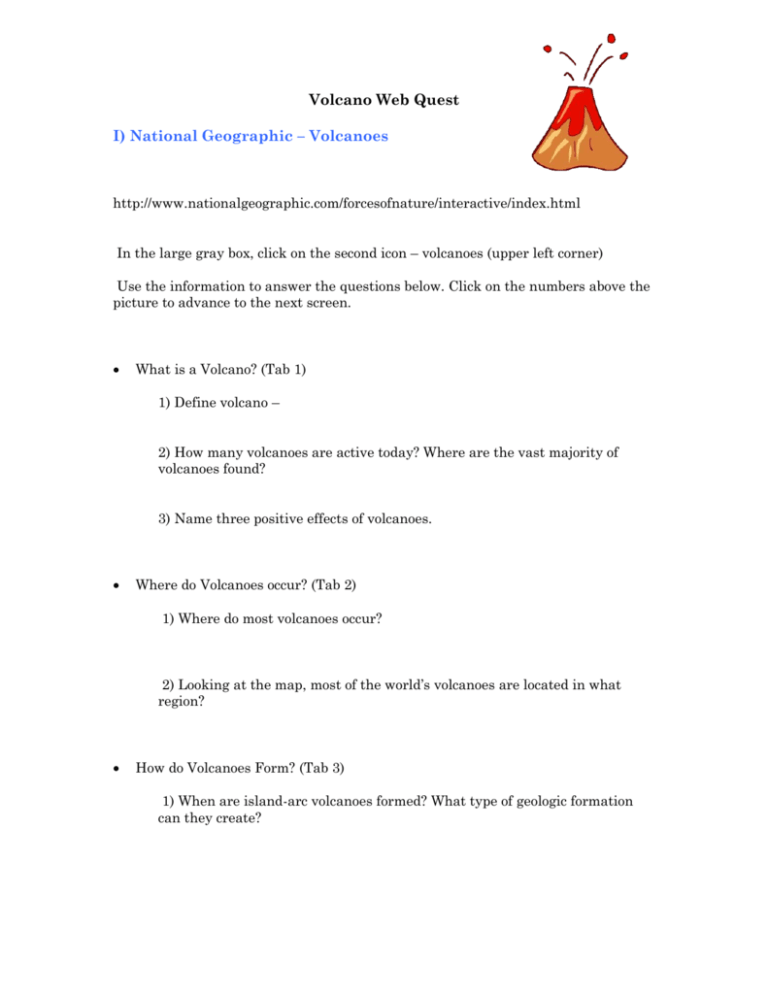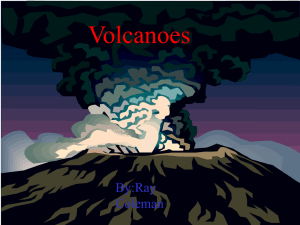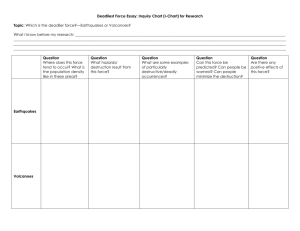Volcano WebQuest
advertisement

Volcano Web Quest I) National Geographic – Volcanoes http://www.nationalgeographic.com/forcesofnature/interactive/index.html In the large gray box, click on the second icon – volcanoes (upper left corner) Use the information to answer the questions below. Click on the numbers above the picture to advance to the next screen. What is a Volcano? (Tab 1) 1) Define volcano – 2) How many volcanoes are active today? Where are the vast majority of volcanoes found? 3) Name three positive effects of volcanoes. Where do Volcanoes occur? (Tab 2) 1) Where do most volcanoes occur? 2) Looking at the map, most of the world’s volcanoes are located in what region? How do Volcanoes Form? (Tab 3) 1) When are island-arc volcanoes formed? What type of geologic formation can they create? 2) What is an intraplate volcano? What causes their formation? Give an example (see map) 3) What types of volcanoes are formed at spreading centers? How does this occur? 4) How does subduction create volcanoes? Where can subduction volcanoes be found? Types of Volcanoes (Tab 4) 1) Name the six types of volcanoes. 2) Choose 2 and explain them more depth. How do Volcanoes Erupt? (Tab 5) 1) When does an eruption begin? 2) What determines if an eruption will be explosive or nonexplosive? Explain. 3) What is viscosity? What determines a magma’s viscosity? Explain. 4) What causes lava to be fluid and runny? What causes lava to erupt as pyroclasts? 5) A volcano can erupt in many different ways. Describe two. Make Your Own Volcano (tab 6) 1) Describe a high dissolved gas, high silica content eruption. 2) Describe a low dissolve gas, low silica content eruption. Click on the “Case Studies” tab. Pick one of the volcanoes to read about. After reading, summarize the case study in 3 sentences and describe the type of volcano that it is. II) When Yellowstone Explodes http://ngm.nationalgeographic.com/2009/08/yellowstone/yellowstone-interactive Click on “Go Below Yellowstone” 1) What is found beneath Yellowstone National Park? Using the scroll button on the right side of the screen, move below the surface of Yellowstone 2) What is a caldera? How hot is it? 3) What is found about 250 miles below the surface? 4) How hot is the plume? What part of the earth is found in? III) US Geologic Survey – Volcanic Hazards The USGS issues volcano alerts in regards to the danger of an imminent volcano eruption. “Green” volcanoes pose no threat; “yellow” volcanoes could pose a threat in the far future, “orange” volcanoes pose an imminent threat and “red” volcanoes are currently erupting. http://volcanoes.usgs.gov/ Click on “Activity” 1) How many volcanoes are “green?” Name two of them. Where are they located? 2) How many volcanoes are “yellow?” Name two of them. Where are they located? 3) How many volcanoes are “orange?” What is its name? Where is it located? IV) Bonus – Google Earth 1) Using Google Earth, locate one volcano from each of the volcanic hazard lists above. For each one, list the name, location and geographic coordinates (latitude and longitude). One point bonus for each one completed (maximum of three).








